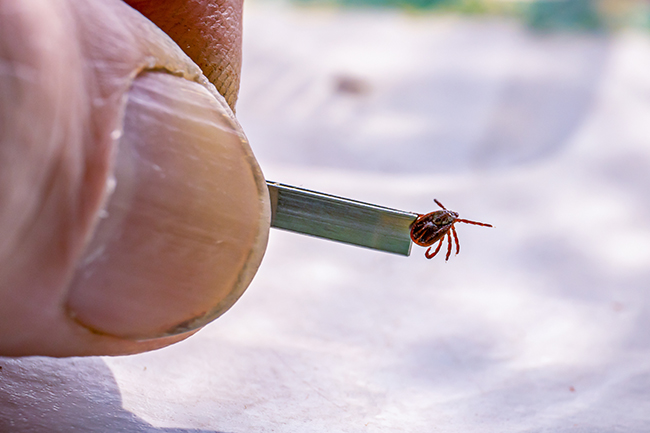
Time to turn up the heat on summer safety
By Canadian Centre for Occupational Health and Safety
Heat, poor air quality, biting insects, and inclement weather can put workers at risk

To prevent heat exhaustion, workers need to stay hydrated. (justocker/Adobe Stock)
The sun is shining, the birds are chirping, the grass is growing, and all seems well in the summer heat.
And while for the most part, this sunny season is a welcome change from the bitter chill of winter, the warmer weather can introduce hazards that employers need to protect their employees from.
Conditions like the heat, poor air quality, biting insects, and inclement weather can put workers at risk for illness and injury, but by supporting workers with hazard assessments, training, and safety measures, you can help to keep them safe.
Identify the risks
Start by implementing a risk assessment to identify objects, situations, and processes that may cause harm to your workers, and then analyze and evaluate the likelihood and severity of each hazard. Once those have been determined, you can decide what measures should be put in place to effectively eliminate or control the hazard.
Risk assessments should be completed before new processes or activities are introduced; before changes are introduced to existing processes or activities — including using new tools and equipment; and when new hazards are identified.
To help identify hazards, consider working as a team and including both people familiar with the work area, such as a crew manager or health and safety committee member, as well as people who are not — this way you have both the experienced and fresh-eye perspectives as you conduct the inspection. Assess all aspects of the work, including non-routine activities such as maintenance, repair, or cleaning.
With an assessment in place, you’ll notice how the changing seasons can shift safety hazards and their subsequent precautions. Where ice and snow may have risks that you’ve previously planned for, you now may be focused on hazards such as working in the heat — and lightning, which seems unlikely but is still possible.
Don’t strike lightning off the list
According to Environment Canada, lightning injures 180 people each year. To keep workers safe, train them on what to do and where to go when a storm is approaching.
They should know that the safest place to be in a thunderstorm is inside a fully enclosed building that has electrical wiring, plumbing, telephone line, or antennas to ground the lightning — if the building should be hit directly.
Workers should stay away from doors, windows, fireplaces, and anything that will conduct electricity such as radiators, stoves, sinks, and metal pipes, and use only battery-operated telephones and appliances during the storm.
Workers who can’t go indoors need a backup location. The next best place to wait out a storm is in an enclosed metal vehicle that is not parked near trees or anything tall that could fall over. Windows should be rolled up, and workers should be careful not to touch any part of the metal frame or any wired device in the vehicle (including the steering wheel or plugged-in cell phone).
Workers should also know where not to be: covered picnic shelters, carports, tents, and baseball dugouts with no electricity or plumbing to ground the lightning are not safe during a storm.
Always wait at least 30 minutes after the last rumble of thunder before going back outside – lightning strike injuries can happen if workers do not get to a safe place quick enough, or if they go back out too soon.

Protective clothing can reduce the risk of ticks attaching to skin, but if that does happen, workers should carefully remove the tick, without crushing it. (Rafail/Adobe Stock)
Bite-sized tips for bug bites
Just as heat and humidity make for a stormy forecast, they also create an ideal environment for mosquitoes and their bites.
And unfortunately, an itch may not be the only result of a bite; it can infect you with the West Nile virus, too. Once infected, West Nile virus may cause no symptoms or flu-like symptoms (for example: fever, headache, body aches) and in the most severe cases, death.
To reduce workers’ risk of developing the West Nile virus, try to limit outdoor activities between dusk and dawn. If staff must be outside during these times, be sure they cover up by wearing socks, shoes, and light-coloured, long pants and long-sleeved shirts.
Clothing should be sprayed with insect repellent containing DEET to prevent mosquitoes from biting through thin clothing. Before using insect repellents, workers should read the label carefully and follow the directions.
Covering up doesn’t just prevent mosquito bites; it can also reduce exposure to poisonous plants like poison oak, and bites from other insects, including ticks. Protective clothing can reduce the risk of ticks attaching to skin, but if that does happen, workers should carefully remove the tick, without crushing it, by gently grasping the head and mouth parts as close to the skin as possible with fine-pointed tweezers, and pulling slowly to remove the whole tick, ideally within 36 hours of the bite. This can help prevent the transmission of disease, such as Lyme disease.
If you’re able to keep the tick in a sealed container, your local public health unit may test the tick for Lyme disease. Contact your local health unit for more information on how to report tick bites.
Keep your cool, breathe easy
For workers who are outdoors and exposed to the elements, they must be able to take the proper precautions to prevent heat stress and be trained to know the signs and symptoms of heat-related illnesses such as heat cramps, heat exhaustion, and heat stroke.
Symptoms of heat-related illness may start suddenly, and include nausea or irritability, dizziness, muscle cramps or weakness, feeling faint, headache, fatigue, thirst, heavy sweating, and high body temperature.
To prevent heat exhaustion, workers need to stay hydrated, and drink about one cup of water every 15 to 20 minutes, avoiding caffeine or alcohol, which can dehydrate them.
If possible, workers should stay out of the sun as much as possible. Check the temperature, humidex, and UV Index for the day and plan jobs accordingly. If tasks are physically demanding, schedule them for the early morning or late afternoon hours when the sun is less intense.
Workers should also be able to take breaks from the sun and heat to cool off in the shade or in air-conditioned buildings or vehicles. If a shady or cool place is not available, they should know it’s okay to reduce their physical effort.
Protection also comes in the form of equipment and clothing. Workers should wear lightweight, loose-fitting clothing, UV-rated sunglasses, and a wide-brim hat for protection. Apply sunscreen with a Sun Protection Factor (SPF) of 30 or higher as well as UVA and UVB protection.
The summertime heat and humidity can increase air pollution, making it harder for people with bronchitis, emphysema, and asthma to breathe, or can cause heart problems in others.
Check the Air Quality Health Index on a regular basis. When the air quality is poor, reduce or reschedule outdoor physical activities. Monitor everyone for breathing difficulties, coughing, or irritated eyes, and check in with workers frequently to ensure they’re feeling okay and encourage breaks throughout the day as needed.
A forecast for worker safety
With the hot weather approaching, employers need to protect staff from the hazards of summer, helping them work through the sunny season safely, and with care.
Working safely includes many different actions, from everyday protective steps to comprehensive planning.
By completing a risk assessment, providing training, and putting safety precautions in place, workplaces can not only predict, but also plan for, a healthy summer for all.
The Canadian Centre for Occupational Health and Safety (CCOHS) promotes the total well-being — physical, psychosocial, and mental health — of workers in Canada by providing information, advice, education, and management systems and solutions that support the prevention of injury and illness.